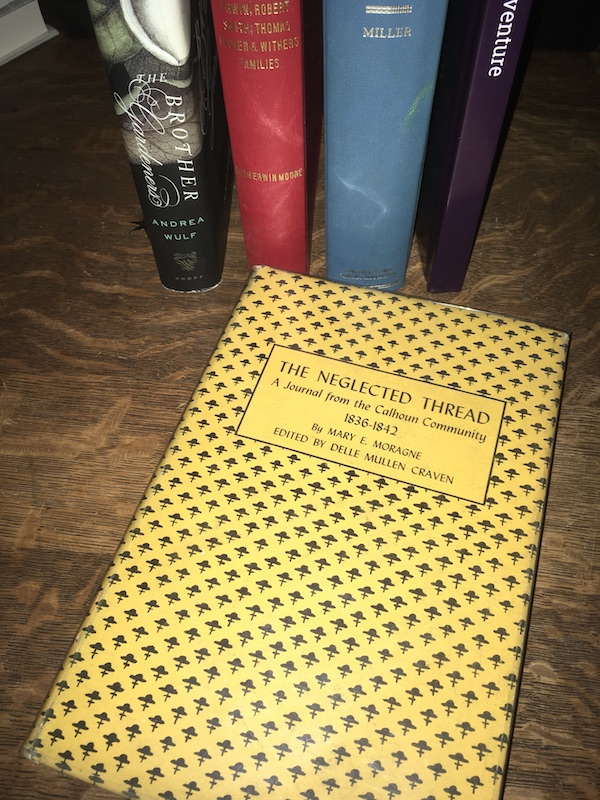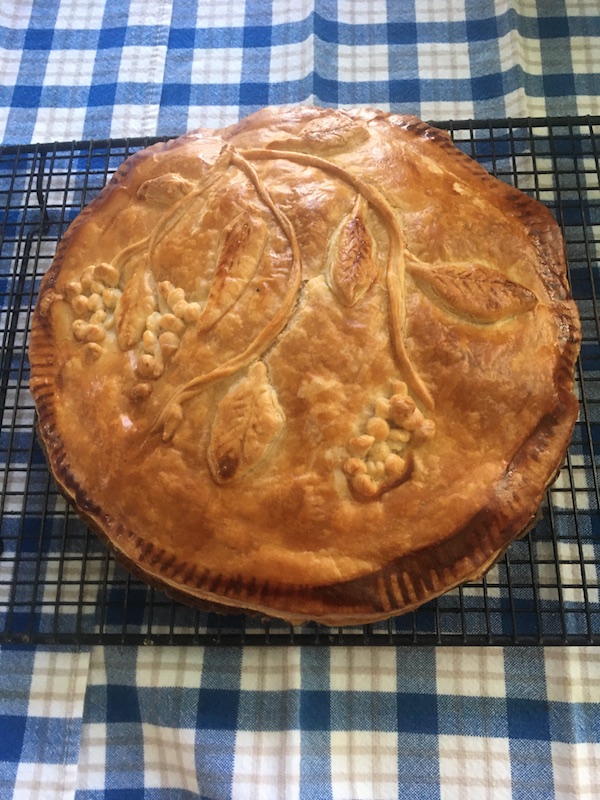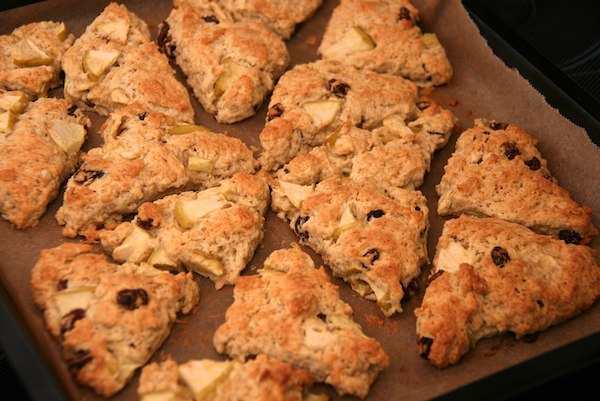Welcome to The Masquerade
“Since the isolation protocols began, I’ve baked bread loaves; I’ve done a cheesecake for a friend; I’ve made Dutch Babies when I was feeling nostalgic for my Grandmother Balk’s breakfasts; and I have indulged my sinful obsession for scones. Now, any Southern baker is trained from birth in the making of a great scone—only, she doesn’t always know it. Learning to make light and fluffy biscuits—as we all must do, of course—is essentially learning to make scones. Once one is comfortable with southern biscuit technique, making scones should be a breeze. I rarely make biscuits, myself; but scones I will make at the drop of a hatpin. In fact, I’ll be making a batch for next Sunday morning.” —William A. Balk, Jr.
Epicurus’ Porch
By William A. Balk, Jr.

ELKO South Carolina—(Weekly Hubris)—1 June 2020—Like many of us all over the world, I’m exhausted by all the non-stop, ubiquitous ‘Rona stories consuming all the air in the room. Also like many of us, I have managed to remember a few interests and hobbies from “before,” activities to divert from the perpetual threat of depression and the recurring urge to spit on unmasked shoppers on my once-a-week trip to the grocers to quickly stock up on essentials.
I’ve managed to get some reading done, but, in truth, my ability to concentrate long enough to read an entire book has left me with a stack of partly read books in several genres. I did, to my surprise, finish one, although it took me five days; usually, a 300–500 page book is finished in one or two days of reading. This was a journal, dating from 1835 to 1840, kept by the sister of my grandfather’s grandmother during a short period in her 20s, recording the daily social life in a community in the South Carolina back country. The town, New Bordeaux, had been settled some 60 or 70 years earlier by the last of the French protestant refugees to flee to South Carolina, carving out a village not too distant from the Savannah River in the Piedmont region of the state.
I had turned to the book expecting to find a sympathetic voice describing the hardships of frontier life, with vivid descriptions, I expected, of how they managed under trying conditions of isolation and deprivation to survive. Something to give me a little inspiration perhaps for our coping with toilet paper shortages and disappearing hand sanitizer.
I can’t say I was disappointed, honestly, to find a lively and engaging young woman with a sharp eye and a perceptive intelligence. The life she describes was full of frequent visits, parties, even dancing, despite the loud protestations of the Methodist ministers in the community. Clearly privileged and apparently wealthy by this time, many in the Huguenot community were able to import French silks, locate fancy foodstuffs, and afford multiple wagons and carriages to transport them on trips to a city like Augusta, across the river in Georgia. The central figures all held enslaved people to do the work of maintaining their farms and households; Miss Moragné describes several incidents—horrifying to read—between the slave owners and those enslaved, but the horror comes from the reader’s understanding, not the writer’s, who conveys no particular revulsion or criticism of the awful acts portrayed.
Reading and genealogy interests thus addressed, I have managed to dip a toe in the waters of gardening, which has been so essential a fascination for so long that I suspect it is genetic and part of my makeup. With arthritis increasing its evaporation of the connective tissues all through my body, actual physical gardening is becoming less of a pleasure and more of a session on the medieval rack. As a Master Gardener, I was trained to assist other gardeners with questions and issues about their gardening and to provide guidance and training in horticultural subjects for the public. I managed to accumulate some 3,000 hours volunteering with the Extension Service doing precisely that.
Nowadays, I find that, while I’m no longer in the Extension office, there is apparently an institutional memory of my being able sometimes to solve confusing problems for gardeners; weekly I will get emails and messages asking to identify a garden plant or weed, to supply an appropriate treatment for a disease, or to try to find a source for an unusual plant. In addition to providing me with topics for my gardening column in the “Lowcountry Weekly”[ http://www.lcweekly.com/] newspaper, these inquiries offer ample opportunity to fill in with broader information, as well. For instance, I just received a question from an old friend, a New York literary agent—not about my scrivening, I must point out—about a spectacular shrub in the garden of their new home in Beaufort, accompanied by a couple of photos. “What is it?” they asked. The answer was simple for many gardeners familiar with the glorious gardenia of southern gardens, but my questioner was unfamiliar with it.

The simple answer wasn’t the good part, though. It gave me the chance to point out that the great Swedish botanist and zoologist, Carl Linnaeus (who formalized the use of binomial nomenclature in naming plants, animals, and other organisms) named this plant Gardenia in honor of the prolific botanist and doctor, Alexander Garden, who lived in the Lowcountry during the 18th Century. Dr. Garden was a frequent contributor of New World plant material to Linnaeus and European plant collectors. He had plantations outside of Charleston, calling his home plantation “Otranto,” and one just outside of Beaufort, my questioner’s new hometown. Driving into Beaufort from the north, a traveler must turn south at Garden’s Corner, near the site of Dr. Garden’s Beaufort property.
Marly and Mihai’s sweetly scented flowering shrub connects their new home in Beaufort to three centuries of the history of the area, to the worldwide craze for plant exploration in the 18th and 19th centuries, and to the creation of the scientific system of taxonomy. My friend’s delight was clear, as was mine.
I wonder if everyone confined during this Time of the Pandemic has yielded so utterly as I to the temptations of the kitchen. I’ve loved cooking for years, but since my caregiving duties have become so constant, I seem to have let those interests lie relatively unexplored. Until lately, that is.
I’ve begun to submit readily to certain cravings which I used to put aside “until later.” Last week I really, really wanted a taste of the pilau (pronounced “per-low”) my family would prepare several times a month. The urge wasn’t helped when culinary historian and old friend John Martin Taylor wrote from his current home in Cambodia about his own experiences with the classic Lowcountry rice dish. There are pork versions, chicken versions, sausage, turkey, and shrimp versions, all worth making. Inspired, I made enough to feed four for three different meals, using chicken and venison sausage since they were at hand.
A week earlier, I was dying for the breakfast hash my parents used to make for us each Christmas, preparing a dozen pint jars of a concentrated version of the hash to serve over our morning hominy (it’s grits to most people, but for generations in our family and in our area, it was called hominy).
I set about trying to recreate the recipe with little to go on except memory. The ingredients were simple, I knew: The Trinity (onion, green pepper, celery), diced potatoes, meat (turkey or pork was most frequent; I remember beef was sometimes used, and chicken, of course) diced pretty small. And excellent stock, reduced significantly to serve as a thin gravy, intensely flavored. Par-cooked first separately, then combined in the stock to marry and concentrate flavors, the result is ambrosial. Breakfast hash it may be, but I have used my annual bounty over hominy, over rice, over toast, over potatoes. The too-large batch I made a week ago even got used last night for supper, over a big serving of the aforementioned pilau. Breath-taking!
My real joy in the kitchen, though, is baking—breads and pastries. My waistline shows it, too. It’s an ongoing fascination with me, but I usually let long periods pass between those times when I allow myself to indulge in a baking frenzy. This year’s actually began some eight weeks before we had to quarantine ourselves here on the farm, when I decided to bake a traditional French King’s Cake for the Feast of the Epiphany—even though I’d never tried to make one before, the recipe I found looked so enticing I was simply forced, against all sensible judgment, to try to make it.

The supposedly classic recipe is essentially an almond cream filling in a puff pastry crust. Pretty simple, actually, if you discount all the work. I did, of course, discount all the work; I spent the day learning how to make a decent puff pastry and an almond cream filling, and the result so astounded me with its incomparable yumminess, that I promptly set about making six others to give as gifts to very special friends and family. It took three days, but it was worth it!
Since the isolation protocols began, I’ve baked bread loaves; I’ve done a cheesecake for a friend; I’ve made Dutch Babies when I was feeling nostalgic for my Grandmother Balk’s breakfasts; and I have indulged my sinful obsession for scones.
Now, any Southern baker is trained from birth in the making of a great scone—only, she doesn’t always know it. Learning to make light and fluffy biscuits—as we all must do, of course—is essentially learning to make scones. Once one is comfortable with southern biscuit technique, making scones should be a breeze. I rarely make biscuits, myself; but scones I will make at the drop of a hatpin. In fact, I’ll be making a batch for next Sunday morning!
The Queen (here I refer to Betty Windsor, not a self-reference) has permitted the royal pastry chefs to release the palace’s garden party scone recipe, which I find is pretty much like my own recipe. HM serves her scones with clotted cream and a schmear of jam; I think mine are fine just as they are, if they are served fresh from the oven. What follows is my way with scones.

Sunday Morning Scones
Ingredients:
Dry:
3 cups all-purpose flour
½ cup sugar
5 teaspoons baking powder
½ teaspoon salt
¾ cup butter
Wet:
1 cup buttermilk or cream or half and half
1 egg
These scones are a bit on the sweet side, but not overly so. I often mix in some fruit, like blueberries, or some sweetened orange rind; but my favorite addition is currants or raisins and chopped toasted pecans or almonds. They are excellent without any additions at all. (It should be obvious that an adventurous baker might decide to leave out the sugar from this recipe, and perhaps add something savory such as leeks and ham or cheese and spinach. The possibilities are endless!)
Prep:
Some preparatory work is very helpful. I will freeze the butter and grate it in large-ish shreds and keep frozen until putting everything together. Similarly, I will measure all the dry ingredients—flour, sugar, baking powder, and salt, mixing or sifting them together.
Add the chilled and grated butter and mix thoroughly so that there are separate bits of butter all through the dry mixture. Set aside in the refrigerator to chill.
If I am using raisins in the recipe, I usually chop them very coarsely, having first sprinkled a little flour over them to keep them from sticking too badly together or to the knife; I fluff the chopped raisins so the bits don’t clump or sink to the bottom of the batter. After toasting the pecans, I do the same—toss with a little flour and chop very coarsely. The amounts to add are personal choices, but I usually use about a half cup of raisins and a half cup of nuts. I’ve been known to use twice that. Add the chopped fruit and nuts to the dry ingredients in the fridge; keep chilled until ready for the final mixing.
About the flour:
This recipe uses all-purpose flour; I prefer Adluh and White Lily brands, since they usually use soft southern wheat, which yields a tenderer biscuit or scone. Many (most?) southern bakers swear by self-rising flour—again from Adluh or White Lily, or a mill which uses soft wheat flour. Self-rising flour has baking powder and salt already mixed into it, so using it instead of regular all-purpose flour would require eliminating both baking powder and salt from the recipe. I rarely use self-rising flour since I use so little of it; the baking powder tends to lose some of its leavening power if it sits too long, and I find it easier to mix fresh baking powder into the recipe each time.
Making your scones:
Have your oven preheating to 400°F while you assemble your chilled ingredients; prepare your baking sheet with a sheet of parchment paper. Your local grocery store stocks parchment paper on
the same shelf as their wax paper, near the plastic stretch wrap. It makes handling the steps of
baking so much easier, and it serves as a superb non-stick guarantor.
In a small bowl, mix the egg and the cup of buttermilk or cream; pour the liquid ingredients into the dry ingredients and mix them very gently, trying to avoid working the flour too much or for too long. As soon as it is clumped together pretty well (don’t try to work it into a smooth ball of dough; that results in a tough scone), dump it onto a very lightly floured surface. You don’t want to add too much more flour—just enough to keep the dough from sticking.
With your hands or a pastry scraper, gently lift the edges of the dough toward the center and fold the dough until it comes together enough to make a crumbly ball. There should be some dry floury spots, and buttery lumps should be visible. Gently flatten the ball into a disc shape, a half inch or ¾ inch thick.
I should note here that if this process of mixing the ingredients and making the disc has taken more than a few minutes, it might be a good idea to pause and chill the disc, covered in plastic, for 15 or 20 minutes. If the dough is still cool to the touch, then go on to the next step.
Shaping the scones:
The classic scone is a triangular biscuit: simply cut the round disc with a knife or pastry knife into six or eight wedges like you cut a pizza. If you have your dough disc on your sheet of parchment paper, you can cut the wedges and lift parchment paper and wedges onto your baking sheet.
Some bakers prefer a round scone, more biscuit-like, and for that you will need a biscuit cutter—2 inches is usual. Remember not to twist or turn the biscuit cutter; just press straight down to cut out the biscuit shape. There will be left over dough after cutting out your scones, which you gently work into another flattened ball, then cut out another scone or two. (My objection to this approach is that you toughen the dough when it is reworked for the second cutting. These second scones are never as tall or as light as the first cutting.) Arrange the scones on a sheet of parchment paper on your baking sheet, spacing the triangles a half inch or so apart so that the cut edges will rise.
After you’ve shaped your scones, they will benefit from another rest and chill in the fridge for 15 minutes or a half hour, even overnight.
Just before putting the baking sheet of scones in the oven, lightly brush the tops of each scone with cream or milk to get a beautiful brown glaze. Sweet-toothed scone eaters may enjoy a very light sprinkle of sugar crystals, too, but that’s gilding the lily.
Bake at 400° until a rich golden brown, around 15 minutes—more or less depending on your oven.

Regarding the Illustrations: The first image is by William A. Balk, Jr. The second image is by Michael Radulescu and is used by permission of Mr. Radulescu and Marly Rusoff. The third image is by William A. Balk, Jr. The fourth image is by Katrin Gillger, from Wikimedia Commons, Creative Commons License CC BY-SA 2.0.


4 Comments
Diana
Dearest Will, That gardenia is OTT, I never saw anything like it. Our Greek gardenias are so modest in comparison But I do wish I lived next door to you and could be the beneficiary of your baking manias and offerings. I almost never bake, probably because I don’t want large quantities of something tempting in the house, and because I prefer savory to sweet. But I would love to taste all of your goodies.
Also I sympathize with the aches and pains that come with gardening too — the knees do not like kneeling and the back . . .
Will
Ooh! Wouldn’t that be fun, being neighbors? Thanks for the encouraging words – and felicitations on your good fortune, relatively speaking, of having chosen one of the more sane countries to live in during this viral crisis. I’m down to getting out of the house one day a week, and I am sure the Mama would be very grateful if a few different faces showed up occasionally here – virus or no virus! Much love!
Jane Balk Miller
These sound so delicious! Unfortunately, I have had to put aside my love of baking cakes due to worsening of diabetes. I did make Werner my chocolate cake with ganache for his birthday last month and was successful in only having 2 tiny pieces. Werner managed to do away with the rest with a great look of joy on his face! Actually I only made half a cake and put the other layer in the freezer for a future modified black forest torte. I have to wait until the newly begun Insulin ramps up enough to make it safe to eat some. I do so sympathize with your pains. A day without pain is very rare for me as well. I have come to accept it as a companion, however much unwanted. Werner is so faithful to heat pads for my comfort and to make breakfast daily as I try to get in workable mode. I miss you so and would so love for Werner to meet you as well. Take care and keep us posted. Love you!!!
William Balk
Thanks Jane. Still seriously laid up. Check with Ted. Love you!